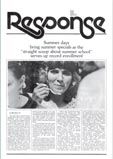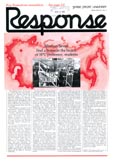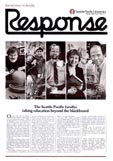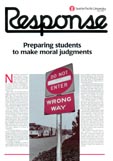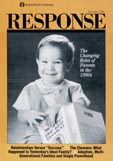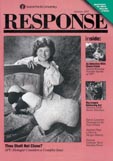 |


|
Summer 2002 | Volume 25, Number 3 | Features | ||
|
A Quarter Century of Response IN 1975, when Response Vol. 1 No. 1 was born, Seattle Pacific was still a college and Gerald Ford was U.S. president. Muhammed Ali and Joe Frazier settled their heavyweight boxing feud in Manila; One Flew Over the Cuckoo’s Nest was named Best Picture; and the Khmer Rouge took control of Cambodia. At a growing Seattle Pacific College, the administration and Alumni Board sought a new communications link with alumni, parents, churches and friends. Innovative for college publications of the day, the tabloid design created by O.K. Devin showcased photos and typography, and featured a flexible format for conveying SPC’s story. The re-engineering effort replaced two publications, SPC Bulletin and Seattle Pacific College Alumni Magazine, both of which had served audiences well for several years, but with often-overlapping information. For the next quarter of a century, Response communicated the story of an emerging Christian university with news, features, profiles, essays, photos and illustrations. Letters to the editor and reader surveys indicated Response gradually earned an unusual loyalty among its largest audience — the thousands of Seattle Pacific alumni around the world. “It wasn’t long before imitations began appearing from other institutions,” says John Glancy ’70, the tabloid’s first editor. “In fact, some almost plagiarized our design. We took it as flattery.” Glancy’s successors at the editor’s desk were Mark Davis; Frid Nutley ’72; Peter Shafer; Mark Cutshall; Petra Roush Martin ’83; and the current editor, Jennifer Johnson Gilnett ’81, who has held the post since 1987. Response has always provided the inside track on campus news. In its first year, readers learned that alumni at Casey Alumni Weekend were examining the “impending” adoption of the metric system; President Emeritus C. Dorr Demaray and his wife, Grace, were celebrating their 50th wedding anniversary; and the SPC Singers were invited by the Army to tour U.S. military bases in Germany. As the years went by, headlines included “The College Becomes a University,” “Seattle Pacific Receives Largest-Ever Cash Gift for New School of Business” and “Falcon Men Go to the Final Four.” A Who’s Who of well-known personalities have come to Seattle as guests of Seattle Pacific, and many have appeared in the pages of Response. They include former Black Panther Eldridge Cleaver, Prison Fellowship’s Chuck Colson, scholar and apologist Francis Schaeffer, best-selling author Madeleine L’Engle and former Secretary of Education William Bennett. Profiles of alumni spotlighted people from every walk of life: an FBI agent, a planetarium director, a dolphin trainer, a Hollywood film scorer, an ambassador to the Fiji Islands, a spine surgeon, the chief of Army chaplains and the creator of a computer language. Readers also enjoyed learning the story within the story. It was in Response that the writer of The Message, Eugene Peterson ’54, confessed he had failed Professor Philip Ashton’s psychology course and colorful soccer coach Cliff McCrath expounded on his four-time broken nose: “I need another broken nose like a rhinoceros needs a sinus problem.” The relocation of Vietnamese refugees and the freeing of “The Siberian Seven” from the Soviet Union were among the more sobering stories covered by Response in 25-plus years. Past in-depth theme issues dealt with choices in education, parenthood in the ’90s, the future of health care and the wonders of space exploration. A review of Response issues over the years reveals changing hairstyles and fashion choices, and highlights the speed with which great differences can occur. In a 1980 Response, one professor marveled over the rapidly changing world of computers: “Today, an employer can pay a secretary $15,000 for one year of work or he can go down to his computer store and pay $12,000 for a nice computer system that will last years.” During his tenure as publisher, former President Curtis Martin brought new energy to Response as a means of communication for the University. Changes in design and editorial philosophy continued to keep the publication fresh. In the 1990s, under Gilnett’s leadership, the tabloid began to focus on providing more continuing education to readers, taking advantage of the University’s faculty, guest speakers and academic resources to offer a variety of insights on issues that affect daily life and culture. “There was a definite shift in editorial stance,” says Glancy, “from primarily reporting campus-related news to also providing features of educational value in their own right. Jennifer has brought a new level of quality and substance to Response.” Throughout the late ’80s and ’90s, Response garnered 10 gold medals in tabloid publishing and was three times judged the best among all university tabloids and magazines in five North- western states and two Canadian provinces. The future of Response as a magazine remains to be written. Gilnett, who in addition to her editorial duties is also associate director of university communications, sees both the benefits and the potential hazards of the new format. “It’s risky,” she says. “Will readers appreciate the change? Will we be able to distinguish ourselves among a large number of similar publications? I’m optimistic that we will.” So is SPU president and Response publisher Philip Eaton: “The time is right for a magazine like this one, that reflects the quality and vision of Seattle Pacific. I think readers will like it as much as I do.”
— BY CLINT KELLY |
Click for larger images.
|
